Fancy Goldfish Transparent Watercolor and Time-lapse Video
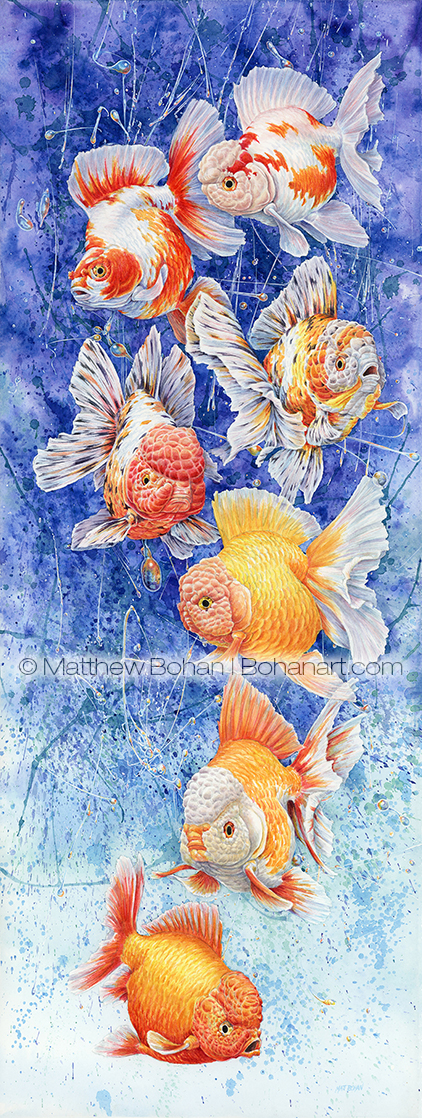
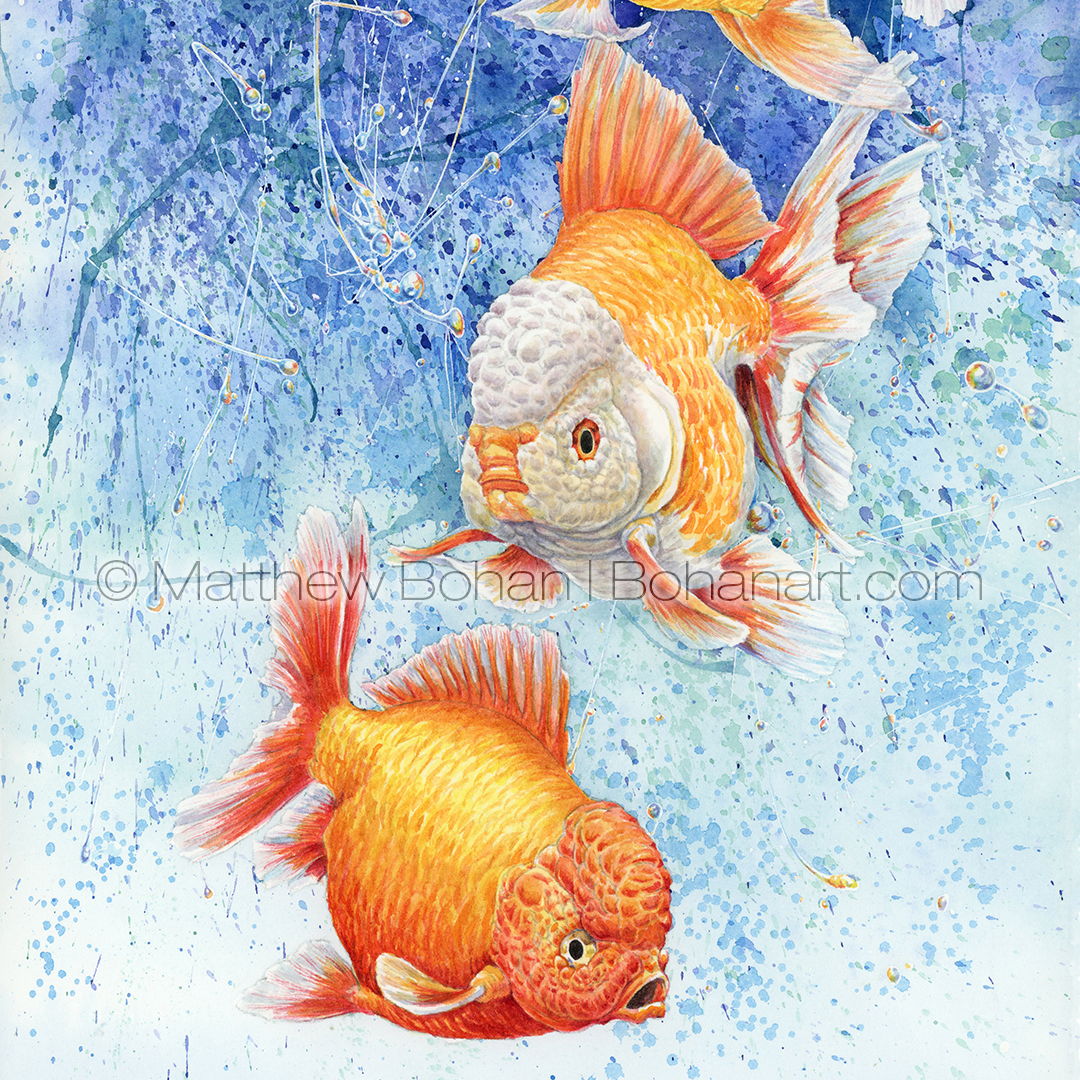
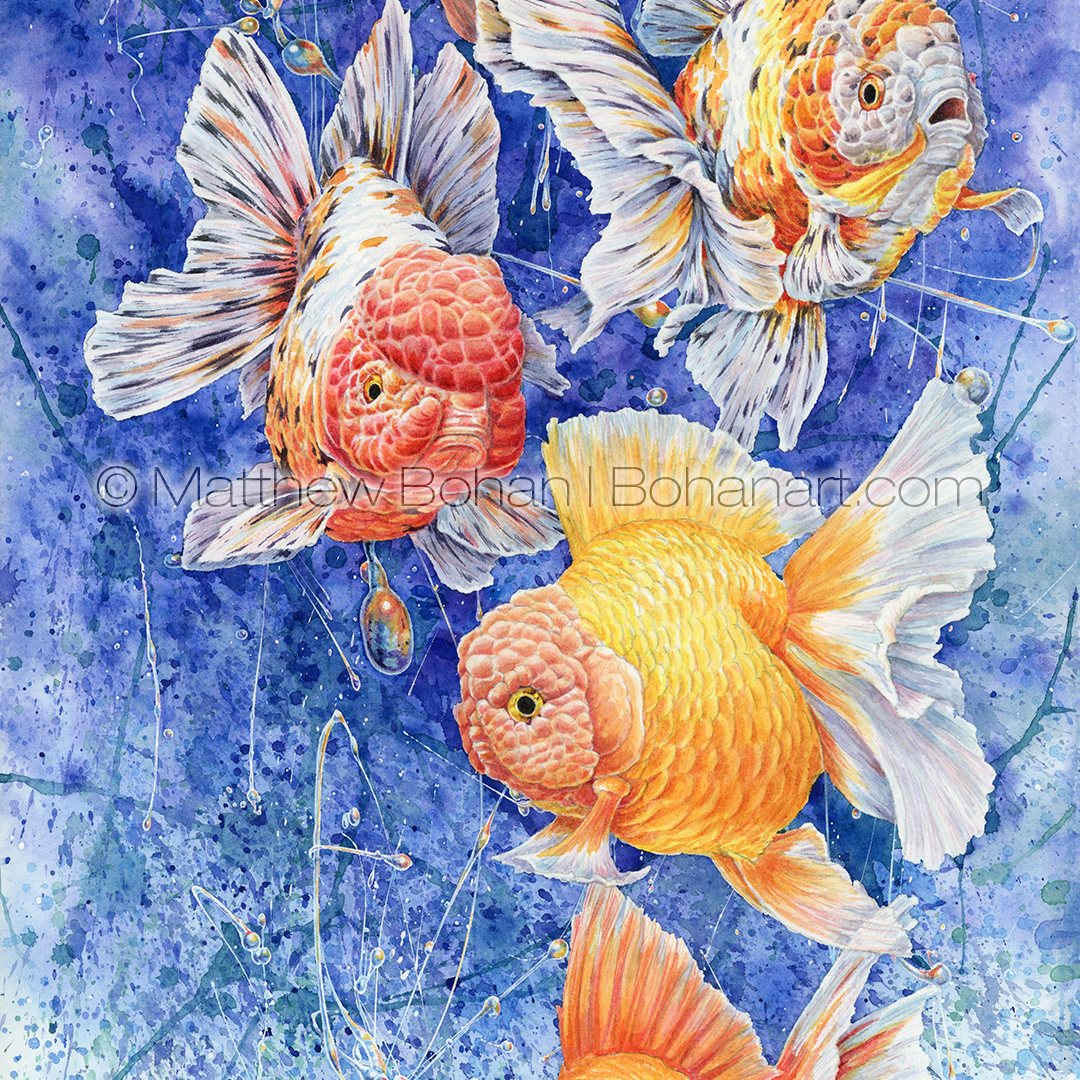

It has been a long time since I painted goldfish in transparent watercolor. I’ve been missing out! They lend themselves perfectly to the medium.
As a kid, my dad had a tropical fish tank. We all enjoyed watching them swimming around happily. Although I was really young, I have two clear memories of that tank. The first was when our angel fish laid a zillion eggs all over the side of a plant. I was convinced that we’d have thousands of tiny fish swimming around in no time and that we were about to go into the fish business! Not a single egg developed.
The other memory involves something I bought for the tank. While at the nearby Weston Mills pet store, I saw that they had an aquarium ornament bubbler that looked like the Lunar Lander from the Apollo missions. Like every kid at the time, I was a bit space and rocket obsessed, so I checked my lawn-mowing money and was ready to buy it on our next visit. Although I’m sure both of my parents thought it was amazingly tacky, my dad said it was okay to put it in the tank. I brought it home, and my dad helped me get it hooked up to the air pump. That was exciting, but… After a while I got a little bored with the spacecraft always floating and bubbling at the same position. To attain the proper level of excitement, I decided it needed a “pilot.” So… I started plugging and unplugging the pump from the wall to change the lunar lander’s level. Now that was more like it! Eventually I ended up getting a whopping shock as my hand slipped across the terminals of the plug while trying to pulse it on and off more quickly. Well, that wasn’t the level of excitement I was hoping for. Understandably, after that voltage discharge the lunar lander saw a lot less kid involvement! Pain, after all, is an unpleasant but incredibly effective teacher. Eventually the lunar lander was covered in algae and mysteriously disappeared. It was replaced one day with a curtain of bubbles coming from a sparkling new air stone. It sure was nice of my parents to indulge me in that hideous aquarium toy!
When I went to graduate school, I started keeping fancy goldfish. My brother Ted soon caught the “bug,” and we became somewhat, um, no, very obsessed with different breeds and how to best get them to thrive. Soon it was a friendly competition to see who could bulk their “goldies” up to unnatural proportions. I visited Ted after being in grad school for a few months, and his tiny goldfish had swelled into leviathans! I was flabbergasted. Ted has always been one for the academic approach, researching all his hobbies with great skill and enthusiasm. After watching me jealously admire his fish, he produced a package of his “secret weapon” that he had bought for me. He had been using a Japanese brand of fancy goldfish food packed with all sorts of fresh, natural ingredients—and probably a dab or two of “unicorn horn” and “tiger paw” for good measure. The majority of the text on the bag was in Kanji or Katakana, but from the massive Red Oranda on the package, there was no mistaking what it promised! Ted comically insisted that if Arnold Schwarzenegger was both a goldfish and Japanese, this would be his “supplement” of choice. As is always the case, Ted knows! After switching to his miracle diet, my fish expanded at an incredible rate. I later supplemented their Japanese meals with peas and other fresh foods.
Before long, my problem was trying to stop their growth! My fancy goldfish kept out-growing their tanks. I found out later that goldfish were believed to continue growing throughout their lives if given enough clean water and space. At the time, scientists theorized that goldfish release a hormone that slows growth. When that reaches a certain concentration in the water, they stop growing. What I discovered was that the “stop growth time” coincided with the time they got big enough to completely pollute the tank with nitrogenous waste. I had to flush out the tank almost completely every week, or they’d start getting sick. I haven’t researched it again since giving up the aquarium life. Maybe the hormone thing has been disproven. In the end I spent less time enjoying the fish and more time cleaning out the tank and medicating them when they got sick.
My last fish died about 10 years ago. He was a gorgeous Oranda between the size of a baseball and a softball: huge! I do miss having fish, but don’t miss the work, which was too much with young children in the house.
I still am a huge fan and have spent way too much time looking at goldfish photos on Instagram. Over the years my brother and I had almost every variety imaginable. Calico Ryukins, Orandas of every color option, Telescope Moors, Lion Heads and Veil Tails were some of the favorites. Every time I go to a pet store, even if I’m just there to pick up something for our dog, I always check to see what fancy goldfish varieties they have… and then peek at the birds to see if they have lovebirds. While I’m there it can’t hurt to see if they have any turtles, snakes or lizards… oh yeah, then there are the guinea pigs, hamsters, mice and rabbits. You know, it really is best that I don’t go in, or I’ll lose an hour.
Please contact me if you’re interested in buying the original or a print of this painting. Some of my work is also available for licensing.
Barn Swallows and Tree Swallows on Breakwall Transparent Watercolor and Time-lapse Video

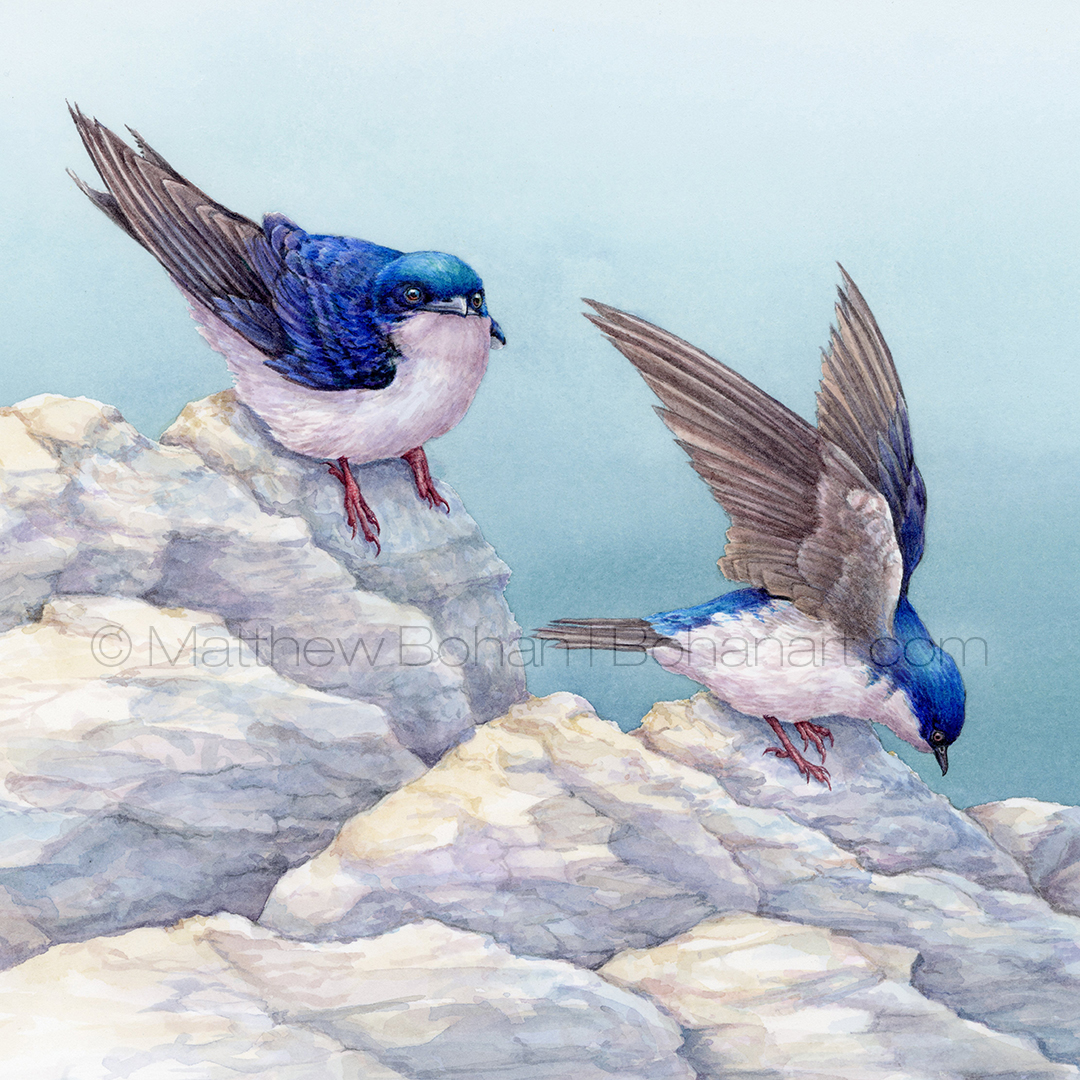
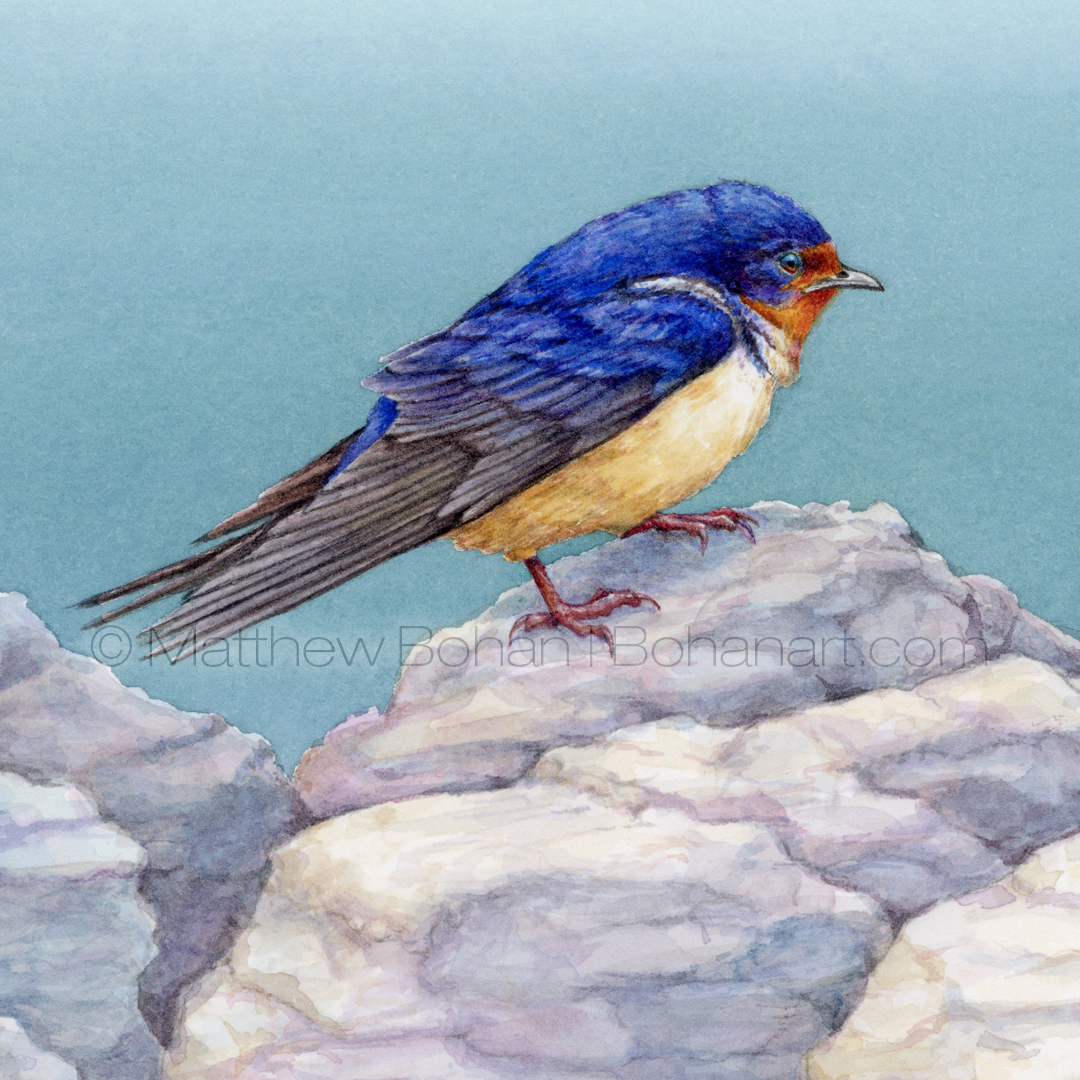
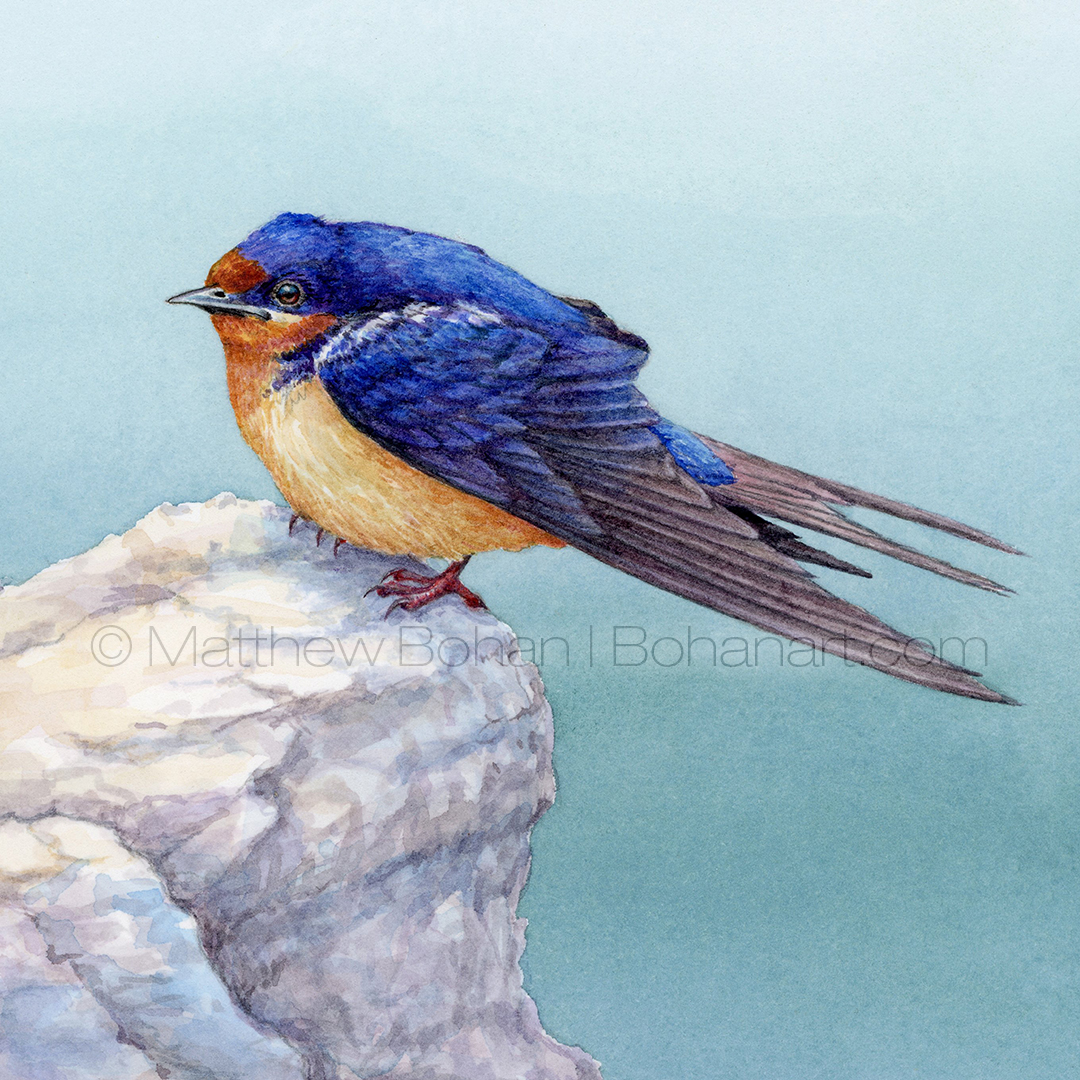
While birding in northwest Ohio last May on a windy, frigid morning, we came across a mixed flock of Barn Swallows and Tree Swallows searching the limestone cobbles of a breakwall for insects to eat. I had never seen that exact behavior before. Although I frequently see the two types of birds near each other, they usually aren’t hanging out like pals. Additionally, I almost always see these energetic swallows zooming around acrobatically like fighter pilots, eating insects mid-flight. I’m guessing the heavy morning rain, cold temps and high wind were keeping all the flying insects grounded. The birds probably were exhausted and hungry from their recent migration.
On the plus side, despite the tough conditions, the swallows were finding plenty to eat there and allowed us to get super close. We used the car as a photo blind as they gobbled up breakfast. As you might have guessed from my back-to-back swallow posts, these birds are great fun to paint!
Please contact me if you’re interested in buying the original or a print of this painting. Some of my work is also available for licensing.
Barn Swallows Transparent Watercolor


I took reference photos of these barn swallows on the Marsh Boardwalk at Point Pelee National Park in Ontario. The swallows kept landing on this particular stick, and they were pretty much oblivious to my standing very close with the camera. They were much more focused on fighting over the prized perch, which made for some animated photos.
Often when setting out to do a painting, I try to set a goal for myself. Usually, it is a skill I’m hoping to improve. A great piece of advice I came across ages ago was from the virtuoso guitarist Steve Vai, but it equally applies to painting. Paraphrasing, he said something along the lines of “Work on your weaknesses until they become your strengths.” I’ve never been great at painting clouds in watercolor, so I thought it might be a good challenge to try some as a background. The range of blues would work well with the colors of the Barn Swallows.
In the past I made clouds quite easily by using an airbrush for the background. In those cases I’d often bring in gouache or opaque whites for the lighter colors. Creating clouds with standard watercolor brushes and washes is a very different skillset and one that I hoped to improve, so it was a good endeavor for this painting.
Knowing I needed significant practice on clouds, I set about doing a lot of tests—21 in fact—before I started to get in the ballpark of where I wanted to be. I’m still far from where I really want to be, so I’ll keep working on them. I remember my watercolor teacher in art school saying that you have to ruin a lot of watercolor paper before you get good at making consistent washes. That seems to be true of clouds as well.
Please contact me if you’re interested in buying the original or a print of this painting. Some of my work is also available for licensing.
Ruddy Turnstone on Oysterbed Transparent Watercolor


I took reference photos for this Ruddy Turnstone along the causeway parks on the way to Sanibel Island in Florida. I’ve been to the Gulf Coast numerous times over the years, but I’m not great with shorebirds and learn a lot on every visit. I’ve lived within an hour and a half of at least one of the Great Lakes most of my life, so I’m a bit limited in the birds I know really well. I’ve seen Ruddy Turnstones more than many shorebirds, but most have been in winter plumage. I considered swapping this one’s plumage for the more exciting breeding phase but eventually chose to paint it with the winter colors I’m more familiar with.
When I took the photos, I was struck by the warm light contrasting against the cool colors of the water. At the time I couldn’t exactly tell what the bird was sitting on: an algae covered rock? Once I reviewed the photos on my monitor, I could see that it was actually composted of oysters, barnacles and algae. While working on the painting, I chose to brag up the colors and define some of the shapes a little better on the “rock” to make it prettier and more stylized. I didn’t want to be too photorealistic when portraying the amorphous green-orange-brown globs that appeared in my photos. They looked like something spawned from the Mucinex mascot.
Please contact me if you’re interested in buying the original or a print of this painting. Some of my work is also available for licensing.
Brown Creeper Building Nest Transparent Watercolor
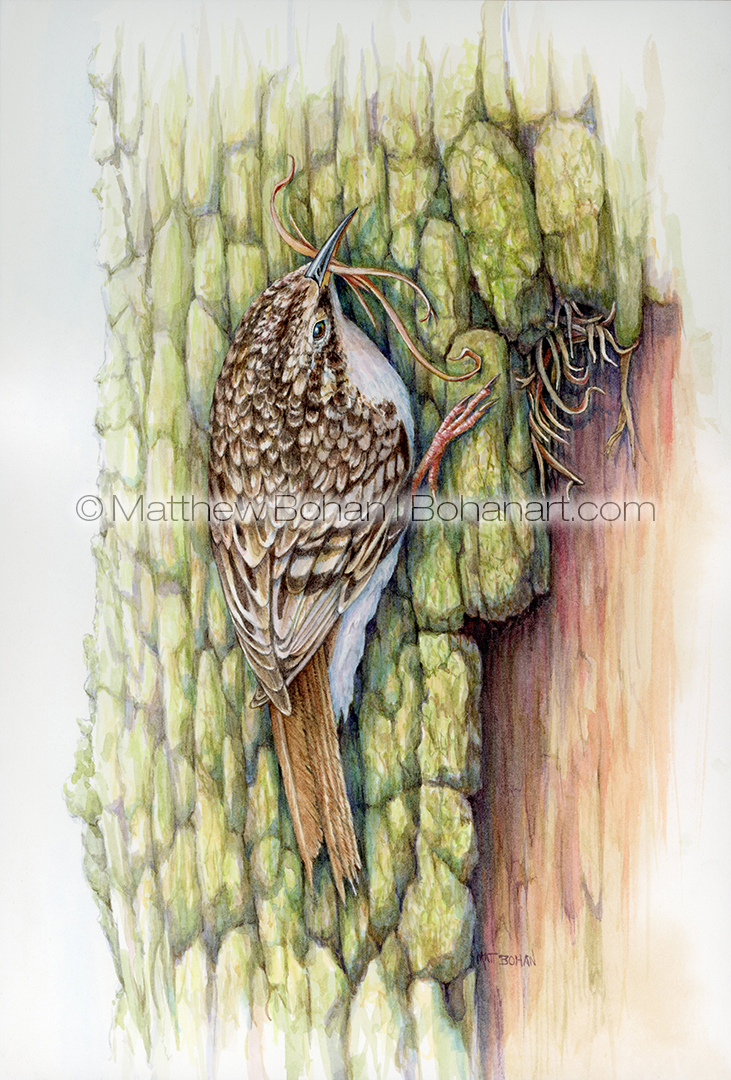
I sure love Brown Creepers! I love the musical, super-high, piccolo-like calls that help alert you to their presence. Without that call they’d be extremely easy to overlook. They are small and cryptically colored, blending right in with the tree bark where they like to forage. One behavior that can make finding them easier is that they tend to land on trees at the bottom and work their way up the bark looking for insects to eat. After they stop finding food, they’ll fly down to a new tree. They act a lot like nuthatches, except they move in the opposite direction.
Brown Creepers like nesting under the loose bark of a tree. I’ve had good luck finding nesting sites. In recent years many of those I’ve found have been on ash trees killed by Emerald Ash Borers. At least there was a tiny benefit to that disaster. All that loose bark makes good nesting habitat. I look for loose grass hanging down from cracks in the tree bark. The creepers carry the material up into the cracks, which are surprisingly small. I have no idea how they keep the young from slipping out, but somehow it works!
Generally, I’m not one to use white backgrounds, but I thought having this painting fade in and out of the page would work well, allowing viewers to focus on the cryptically colored bird. I also chose to play up the green of the bark for the same reason, helping the bird “pop” a bit more.
Please contact me if you’re interested in buying the original or a print of this painting. Some of my work is also available for licensing.
Toyota FJ Caricature (7×10-inch Watercolor and Ink on Arches 140lb HP Paper)

This was a small present for my brother Ted, with two of his favorite things: Penny, his Pit-mix, and his immaculate Toyota FJ. If I could have figured out how to incorporate his incredible woodworking and photography, it would have included four of his favorites.
The original of this painting is no longer available, but contact me if you’re interested in buying a print or licensing a painting.
Northern Parula Warbler Transparent Watercolor
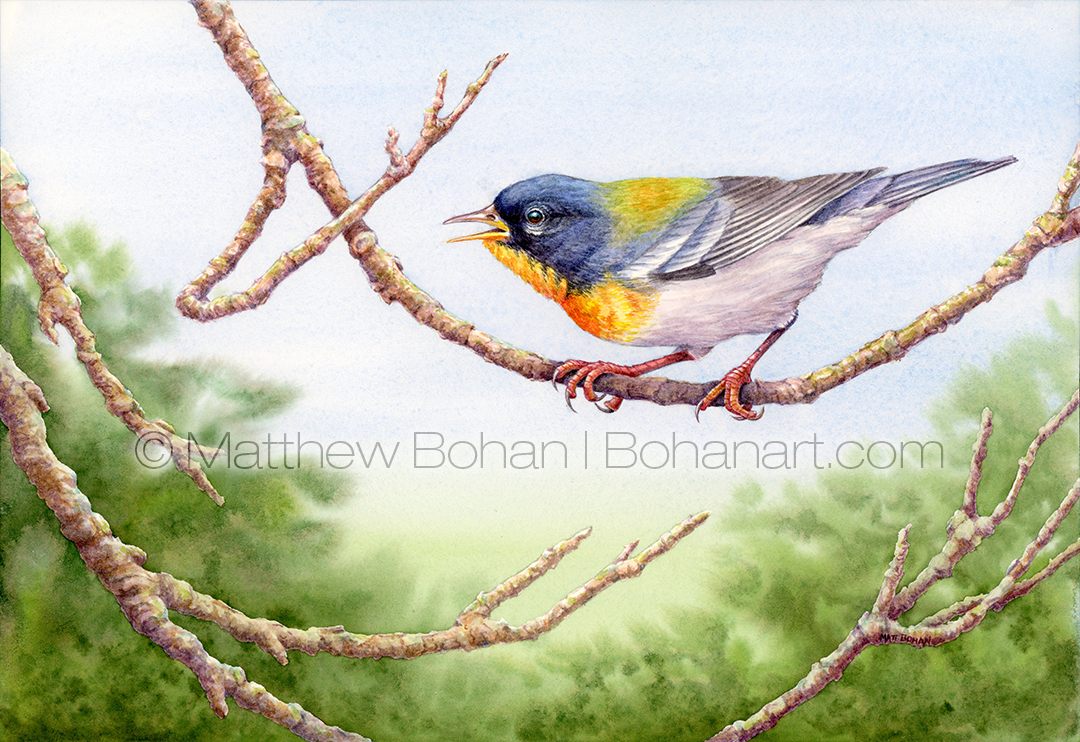
Northern Parulas are great little birds. I tend to see these warblers high in the trees. One of the ways to identify them is a yellow-olive patch on their backs, which is pretty useless when you are staring at their bellies from below. From that point of view, the yellow throat and yellow breast with black and chestnut bands, as well as the partial eye ring in white, are more useful diagnostically.
The original of this painting is no longer available, since we gave it to our son’s organ teacher, but contact me if you’re interested in buying a print.
Bay-breasted Warbler Transparent Watercolor and Time-lapse Video
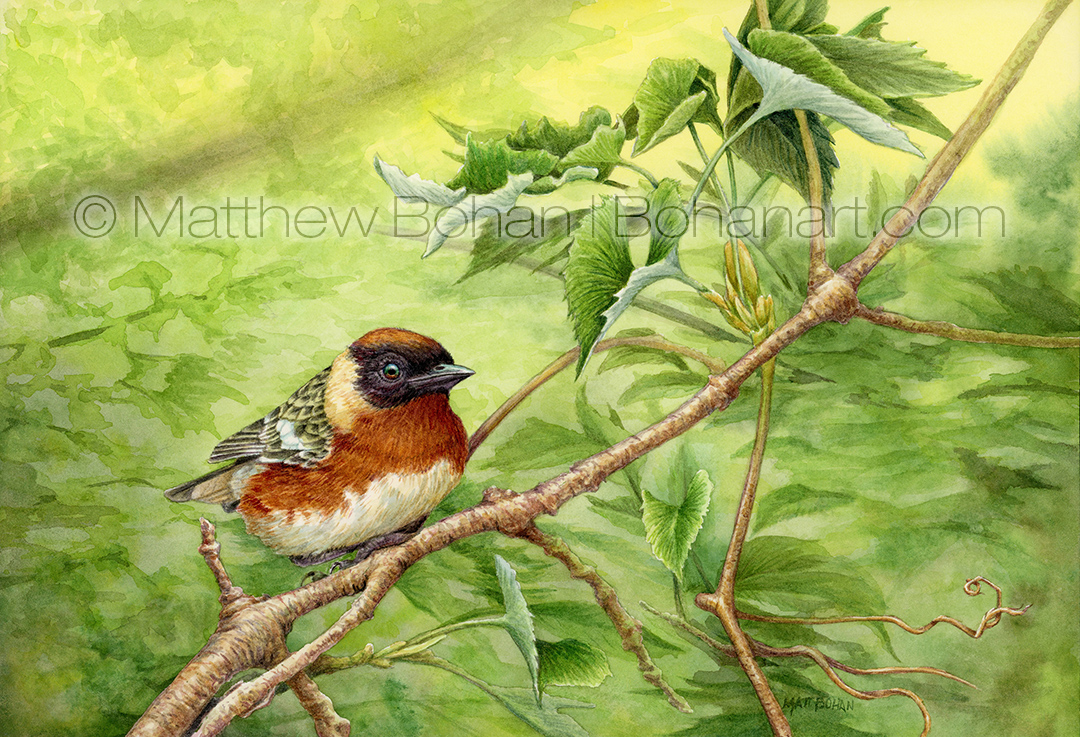
Bay-breasted Warblers are adorable little birds. We occasionally get them on our spring bird outings. However, in mid-May this year they seemed to be everywhere at Magee Marsh in Ohio. In the fall we see many more in our yard than in the spring, but it can be hard to discern between them and Blackpoll Warblers. Fall Blackpolls have yellowish feet and are a bit dingier and streakier than the Bay-breasted Warblers, but often they don’t sit still long enough to see any diagnostic features. I frequently can’t tell for certain and just call them “Baypolls.”
Fall birding is super rewarding. The number of birds, especially warblers, is incredibly high after a successful nesting season because there has been little loss from natural selection yet. The numbers can seem to be 3-4 times higher than in the spring! On the downside, the birds aren’t singing and are sporting drab non-breeding plumage. Birders talk of CFWs, confusing fall warblers, because some of the species are so hard to distinguish. For years our family made a lot of fall visits to the Michigan State Bird Observatory, the local banding station, which REALLY helped us with fall warbler identification.
Cold American Robin Transparent Watercolor and Time-lapse Video
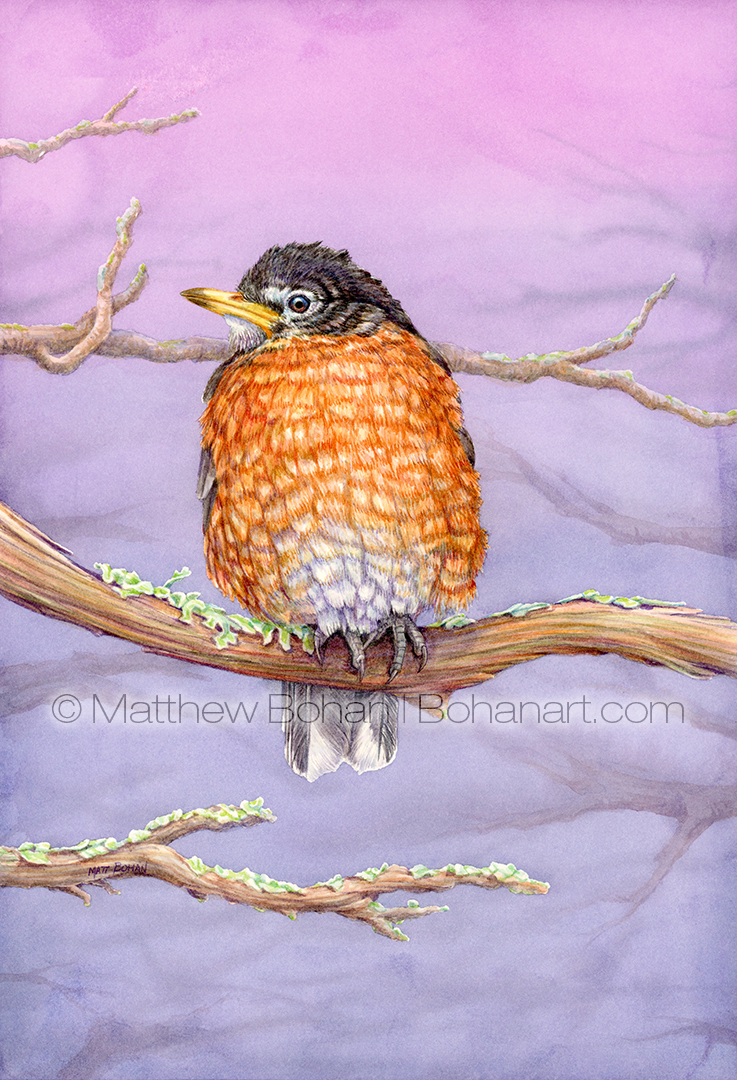
I snapped the photos for this American Robin painting after a rogue April snow shower. The bird was puffed up, looking cold and perhaps a bit annoyed that the winter weather fought its way back for a few more days. Mid-Michiganders joke that you can have all four seasons in one day, and it often feels like that. Although the bird appeared miffed, it posed for many good photos!
People have often told me that they just saw their “first robin of spring,” which is an interesting observation, since many robins actually overwinter here. They switch from foraging alone in yards to eating berries in larger groups. For the most part they do seem to disappear from mid-Michigan in early winter, and in the spring they become more visible as they return to lawns in search of earthworms and other food.
Robins don’t get enough respect. Although common, they really are quite beautiful. I try to take the time every now and again to really study them through binoculars and appreciate their colors.
Chickadee Christmas Feast Transparent Watercolor



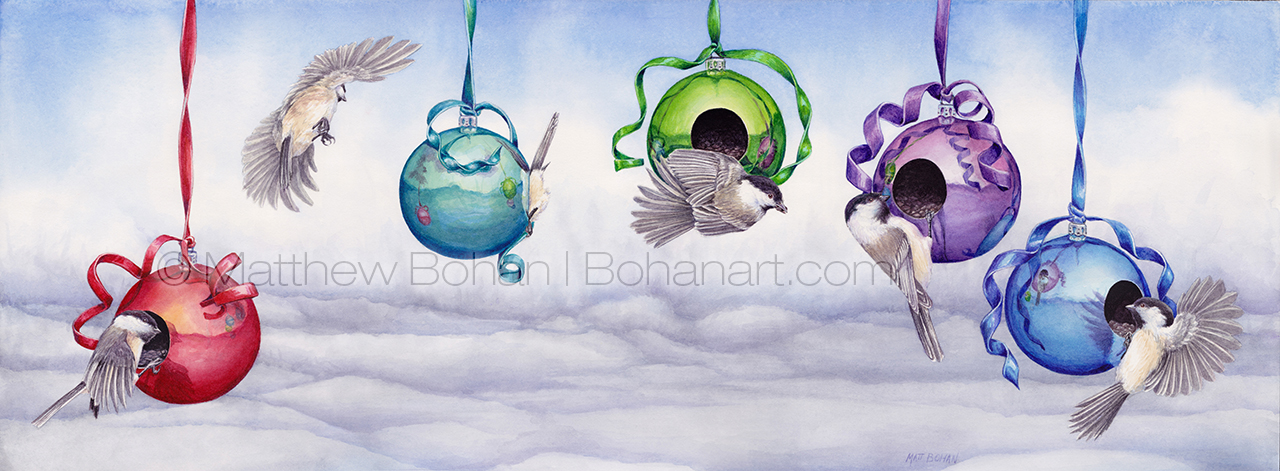
What is more endearing than a Chickadee? Being undeniably cute and having a cheery disposition are a great combination. We have a steady flow of these birds at our feeders year round. A few years ago I saw some big plastic Christmas ornaments at Menard’s for a dollar each and had the idea of drilling a hole in each to make a feeder. I thought I’d be able to get some cool shots of the birds next to the ornaments. Chickadees, being little acrobats, figured them out within a day, making the ornament feeders a big hit with the birds and humans alike. Getting good photos proved much more difficult, as the chickadees seem to move at the speed of subatomic particles. A few hundred attempts resulted in perhaps a dozen decent shots.
My first attempts at converting the ornaments into feeders were functional, but version 3.0 was the best, incorporating drainage holes and glued-in screening to prevent seed spoilage. Some birds species aren’t skilled enough to enter the swinging feeders. Fortunately, House Sparrows and House Finches seem thwarted. Chickadees are masters of shooting in and out; titmice and goldfinches are runners up. An unexpected bonus of the ornament feeders is that on snowy days, the chickadees knock out a fairly constant supply of seeds for the ground feeders, like Mourning Doves and Dark-eyed Juncos, so everyone ends up winning.
I had the idea for this painting for a long time before executing it. I ended up compiling a bunch of different photos and sketched into one piece. To get the ornaments and ribbons in just the right places and colors for the painting I sculpted those in Lightwave 3d and rendered them out in the corrected positions for my Chickadee references. I the experimented with a myriad of colors, positions of birds and ornaments before settling on a long thin horizontal design.
This painting was close to being scrapped in the early stages. I was completely unhappy with my initial background wash. One of my big brushes must have had a clump of unmixed paint stuck to it, and it left a nasty dark streak in what I had hoped would be a super-soft, blurry background suggesting snowfall and sky. I was unable to lift any of the pigment with soft, wet scrubbing. That mark was there to stay. Disheartened, I put it away until the next day. I was hoping to feel more optimistic after a night of sleep but planned to cut my losses and start over. In the morning it didn’t look quite as bad, and it seemed worthy of a bit of time to see if I could work the streak into a more detailed background than I initially planned. In the end I had something that looked different than planned but still workable. Once I started on the detail work, the background didn’t bother me as much. It was fun to work on some glossy metallics in this painting. It had been a while since I did things other than feathers, leaves, scales and fur in watercolor.
I ended up calling it quits on the painting but was never completely satisfied with the background. After it sat in a drawer of my flat files for nine months, I pulled it out to see if the background still disappointed. Yup. After a week or two of thinking about it, I decided to pull out the airbrush and fix up the background. Even if I ruined the painting, I still had a good scan of the previous disappointment. It was worth the risk. I spent a few hours cutting out frisket film to cover the painted birds and ornaments, then I got out the compressor, hoses, airbrush and respirator and went about spraying in a new background. I wish I could say it went by without a hitch, but it has been a few years since I used the airbrush, and I mixed the paints a little too wet, which caused some seeping under the frisket masking the birds. (!) If that weren’t enough, the paint took on a pebbly texture in other areas. This one wasn’t giving up easily. It was a bit of a fight from the beginning to the end. Once the main background was lightened up, I spattered in some “snow” with a toothbrush and white paint. Once it was completely dry, I was able to burnish the bumpy texture away with a piece of tracing paper and a folding bone. It took nine months, but I finally ended up with something I was happy with. I honestly felt like using the airbrush was cheating, but in the end it was the tool that could bring the art back more in line with what I had initially envisioned.
Often I find that I learn the most when things don’t quite go as planned and I have to adapt and improvise to the situation to find a solution. That certainly was the case with this painting. I’m glad I hung in there to see it through to the end. I thought I was finished with this one about four times and went as far as scanning the “completed” work only to find that once I saw it onscreen, there were still things that bothered me and needed to be revisited. I don’t know about other artists, but I can point to something in virtually every painting I’ve done that bothers me. I’m not a total pessimist; I just always see areas to improve upon.
